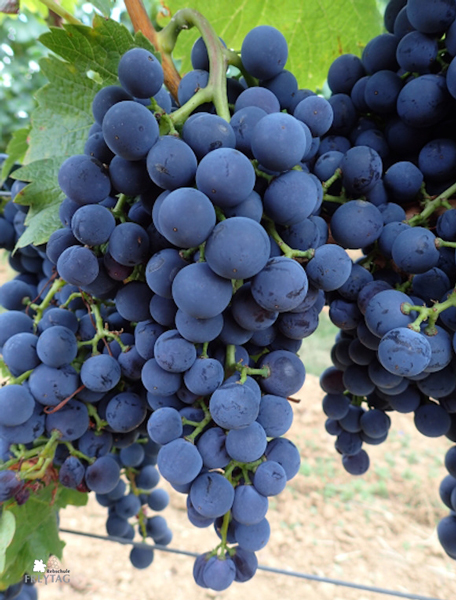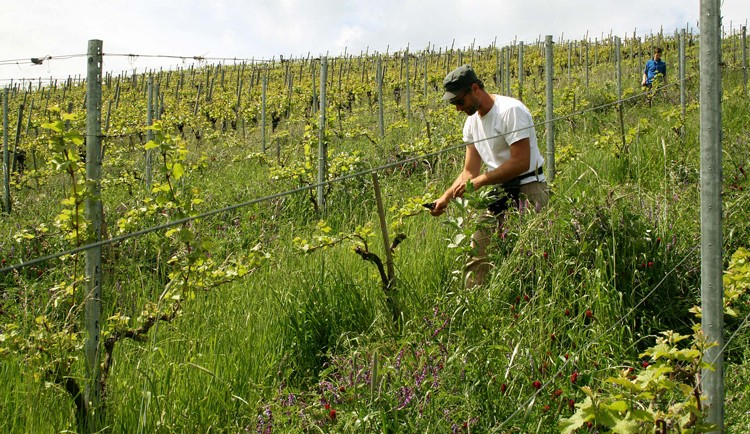Winery Im Hagenbüchle, Achim Stilz, in Schnait in Württemberg
a PIWI pioneer – Pinotin planted in 2008 practically never sprayed
https://www.bonvinitas.com/media/reviews/photos/thumbnail/780x480c/bd/97/2a/weingut-im-hagenbuechle-achim-stilz-in-schnait-in-wuerttemberg-54-1748182690.jpgStarted Natural Winegrowing Early
 View of Schnait in Württemberg. Photo: Photocreatief - stock.adobe The winery is a certified Bioland operation. Stilz: “We focus on a living vineyard and already began permanent greening of our vines in the 1960s, for which we were called crazy by our colleagues. In fact, as early as 1992 we planted Regent, our first PIWI variety, which was only officially approved in 1995.” Schnait lies in a side valley of the Remstal and is part of the city of Weinstadt. The soils consist largely of marl with sandy portions. Achim Stilz is a trained viticulture technician. In 1999, they began bottling their own wine; previously, they were a cooperative member and delivered only grapes.
View of Schnait in Württemberg. Photo: Photocreatief - stock.adobe The winery is a certified Bioland operation. Stilz: “We focus on a living vineyard and already began permanent greening of our vines in the 1960s, for which we were called crazy by our colleagues. In fact, as early as 1992 we planted Regent, our first PIWI variety, which was only officially approved in 1995.” Schnait lies in a side valley of the Remstal and is part of the city of Weinstadt. The soils consist largely of marl with sandy portions. Achim Stilz is a trained viticulture technician. In 1999, they began bottling their own wine; previously, they were a cooperative member and delivered only grapes.PIWI Varieties
Background: Unfortunately, our commonly known grape varieties cannot defend themselves against the two very aggressive mildew fungi, Oidium and Peronospora, which were introduced from the New World in the 19th century and severely attack leaves and grapes already around the time of flowering. Hence, intensive pest control is essential; otherwise, the harvest is largely lost, and even the vines may die. However, since there are wild vines in the USA that apparently resist these fungi, the idea arose to cross such vines with our varieties to transfer these resistance traits. The result is a whole range of PIWI varieties with often good resistance to these fungi.
 Achim Stilz, Weingut Im Hagenbüchle
Achim Stilz, Weingut Im Hagenbüchle  Achim Stilz with his wife Anne
Achim Stilz with his wife Anne
Excellent Dry PIWI Red Wines: Monarch and Pinotin
 Pinotin grape. Photo: Rebschule Freytag For our recent bonvinitas wine rating on March 22, 2021, Stilz submitted Monarch and Pinotin red wines, both from 2018, each rated 89 points by our neutral reviewers (see below). According to our rating system, wines from 85 points are considered “very good,” from 89 points “excellent.” Stilz: “Monarch is my main red wine variety. I have 35 ares, first planted in 2002, later more, and I hardly need to spray them.” For Pinotin, he had planted 15 ares and later added another 20. Monarch is a crossbreed by the State Viticulture Institute Freiburg, successfully bred in 1988 from the PIWI variety Solaris and Dornfelder. Monarch has been officially approved for commercial wine production since 2008. Pinotin was bred in 1991 by the renowned Swiss breeder Valentin Plattner from blue Pinot Noir and other resistant partners and has been officially approved since 2014. Earlier plantings like those by Stilz were only possible as reported and approved trial cultivation.
Pinotin grape. Photo: Rebschule Freytag For our recent bonvinitas wine rating on March 22, 2021, Stilz submitted Monarch and Pinotin red wines, both from 2018, each rated 89 points by our neutral reviewers (see below). According to our rating system, wines from 85 points are considered “very good,” from 89 points “excellent.” Stilz: “Monarch is my main red wine variety. I have 35 ares, first planted in 2002, later more, and I hardly need to spray them.” For Pinotin, he had planted 15 ares and later added another 20. Monarch is a crossbreed by the State Viticulture Institute Freiburg, successfully bred in 1988 from the PIWI variety Solaris and Dornfelder. Monarch has been officially approved for commercial wine production since 2008. Pinotin was bred in 1991 by the renowned Swiss breeder Valentin Plattner from blue Pinot Noir and other resistant partners and has been officially approved since 2014. Earlier plantings like those by Stilz were only possible as reported and approved trial cultivation.Top PIWI White Wines: Johanniter and Muscaris
 Johanniter grape. Photo: Rebschule Freytag For the aforementioned wine rating, Stilz also submitted a 2018 Johanniter Barrique, rated 89 points, and a 2019 Johanniter, proudly rated 90 points, both dry. Johanniter is also a Freiburg cross, bred as early as 1968 from Riesling and another PIWI variety. The wines resemble Riesling with livelier acidity. Stilz: “I grow them in good locations so the wines turn out smooth.” His 2019 Schnaiter Muscaris Auslese scored 91 points, a high-quality wine with residual sweetness (see below). Muscaris was also bred in 1987 by the State Viticulture Institute Freiburg, from Solaris and Yellow Muscat. It makes Muscat more resistant and yields more secure and was officially approved for commercial wine production in 2013. All these varieties show good to very good resistance to the mentioned mildew fungi.
Johanniter grape. Photo: Rebschule Freytag For the aforementioned wine rating, Stilz also submitted a 2018 Johanniter Barrique, rated 89 points, and a 2019 Johanniter, proudly rated 90 points, both dry. Johanniter is also a Freiburg cross, bred as early as 1968 from Riesling and another PIWI variety. The wines resemble Riesling with livelier acidity. Stilz: “I grow them in good locations so the wines turn out smooth.” His 2019 Schnaiter Muscaris Auslese scored 91 points, a high-quality wine with residual sweetness (see below). Muscaris was also bred in 1987 by the State Viticulture Institute Freiburg, from Solaris and Yellow Muscat. It makes Muscat more resistant and yields more secure and was officially approved for commercial wine production in 2013. All these varieties show good to very good resistance to the mentioned mildew fungi.
Breeding Grapevines
Incidentally, breeding grapevines is a very labor-intensive task, first because each individual berry self-pollinates, and grapevines have been propagated through cuttings for thousands of years. Second, the vines resulting from crossings may revert toward unselected ancestral forms and must be highly selected over multiple generations until they produce beautiful grapes.
Text: Dieter Simon, Editor-in-Chief and Publisher of bonvinitas. Photos: PR unless otherwise noted







